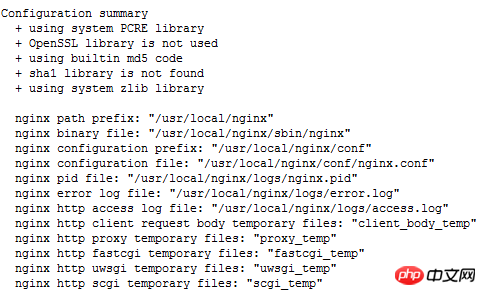
There was a previous blog about setting up a LAMP environment. Today I will introduce another model in detail - LNMP=Linux Nginx MySQL PHP.
1. For the installation process of nginx under Linux system, first go to the website http://nginx.org/download/ to find the version you need to download, and copy the download link address, here it is nginx-1.6. 2. For example, enter the command on the command line:
cd /usr/local/src //将安装包下载到/usr/local/src目录下
wget http://nginx.org/download/nginx-1.6.2.tar.gz
After the download is completed, you will see it in the directory Go to an nginx-1.6.2.tar.gz installation package, decompress the installation package:
tar zxvf nginx-1.6.2.tar.gz
After decompression, enter the command for installation:
cd nginx-1.6.2 //切换到解压后的nginx目录
./configure --prefix=/usr/local/nginx //安装到/usr/local目录下
My server reported an error when executing the above command:

The above error says that the C compiler cannot be found, so install a compiler for you and enter the command:
yum -y install gcc gcc-c++ autoconf automake make
After execution Then use the installation command ./configure --prefix=/usr/local/nginx. The above error is no longer reported, but a new error is prompted:

HTTP heavy Writing modules requires the PCRE library, so you need to install the PCRE library:
yum install pcre
When I enter the command, it prompts me that the pcre library has been installed. Nothing to do... .
At this time, you need to check whether pcre-devel has been installed. Enter the same command:
yum install pcre-devel
Execute the command, and sure enough it is not. devel, enter y to continue the installation. After completion, execute the installation command again:
./configure --prefix=/usr/local/nginx
As a result, another error was reported:

The HTTP GZIP module requires the ZLIB library, but it lacks the library. Follow the above routine again, command:
yum install zlib
Tips I have nothing to do..., haha, continue the command:
yum install zlib-devel
Sure enough, devel is missing again. After the installation is completed, execute the installation command again:
./configure --prefix=/usr/local/nginx
This time the installation was finally completed, it was a complete twist:

Finally execute the compilation command:
make && make install
nginx is much smaller than apache, so the compilation time is also very short. After compilation is completed, switch to the /usr/local/nginx directory and you will see four Directory:
conf mainly places configuration files
html mainly places web page files
logs mainly places log files
sbin mainly places binary programs
If you want to start nginx, you only need to enter the command:
./sbin/nginx
Note: If you have installed apache before, an error may be reported at this time. ,
nginx: [emerg] bind() to 0.0.0.0:80 failed (98: Address already in use) //这是因为你的80端口已经被占用,启动nginx的时候冲突
netstat -tunlp //查看正在运行的服务或软件
Find the software or service occupying port 80 and close it, then enter ./sbin/nginx command, if the character is normal, it should have started normally.
2. Install MySQL with yum:
yum install mysql mysql-devel mysql-server
This There is nothing to say, just y all the way to install it
3. Install PHP:
First go to the PHP official website to find the version you need and download the compressed package. Here we take the php-5.6 version as an example Upload to the server/usr/local/src/ directory, enter the command line mode, enter the command:
tar zxvf php-5.6.36.tar.gz
After decompressing, compile, you need to compile Add some support, such as mysqlnd, ttf, gd, etc.:
./configure --prefix=/usr/local/php --with-mysql=mysqlnd --enable-mysqlnd --with-gd --enable-gd-native-ttf --enable-gd-jis-conv --enable-fpm
You need to pay attention when compiling that errors may be prompted, such as missing some packages. At this time, like The same routine as above to install nginx. For example, I encountered an error that libxml2 was not found. Directly command:
yum install libxml2
prompts me Nothing to do... Another command :
yum install libxml2-devel
Sure enough, devel is missing again. Compile again after the installation is complete. Don’t forget after completion:
make && make install
After the compilation is completed, some PHP configuration operations need to be done:
cp /usr/local/src/php-5.6.36/php.ini-development php.ini-production
cp /usr/local/src/php-5.6.36/php.ini-development ./lib/php.ini
cp etc/php-fpm.conf.default etc/php-fpm.conf
You have completed the LNMP setup here, don’t forget to cd /usr/local/php directory to start PHP:
./sbin/php-fpm
netstat -tunlp

The above is the detailed content of This is definitely the most detailed tutorial on setting up an LNMP environment that you have ever seen.. For more information, please follow other related articles on the PHP Chinese website!
 How to delete blank pages in word without affecting other formats
How to delete blank pages in word without affecting other formats
 Permanently free oa system
Permanently free oa system
 What is the normal temperature of a laptop?
What is the normal temperature of a laptop?
 How to measure internet speed on computer
How to measure internet speed on computer
 What is the difference between golang and python
What is the difference between golang and python
 Introduction to the usage of vbs whole code
Introduction to the usage of vbs whole code
 How to read excel data in html
How to read excel data in html
 How to buy and sell Bitcoin on Ouyi platform
How to buy and sell Bitcoin on Ouyi platform




